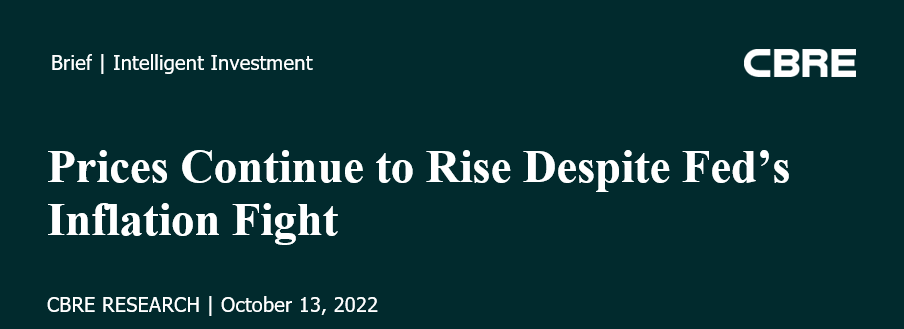
Executive Summary
• The Consumer Price Index (CPI) rose by 8.2% year-over-year in September, slightly above the consensus estimate of 8.1%. Falling gas prices were offset by increases in housing, food and medical costs.
• Core inflation, which excludes food and energy prices, rose by 6.6%. This will keep the Fed on track to raise the federal funds rate by 75 basis points (bps) in November, with another large increase likely in December.
• The economy likely will maintain momentum through the end of 2022; however, we expect a recessionary environment in the first half of 2023. Volatility in financial markets and a tighter lending environment will weigh on commercial real estate investment volume.
September CPI
Prices rose by 8.2% annually in September, up 0.4% from August. A 2.1% drop in energy prices was offset by broad-based price increases, particularly for housing, food and health care. Core inflation, which excludes volatile food and energy prices, increased 6.6% from a year ago and 0.6% from August. With core inflation remaining well above its 2% target, the Fed will continue aggressively tightening monetary policy. A 75-bp increase in interest rates is expected in November, followed by another significant increase in December.
Impacts on Commercial Real Estate
Multifamily
Housing, food and medical costs continued to rise in September, wiping away any relief consumers were getting from lower gas prices. Housing costs were up 0.8% in September. Apartment vacancy is beginning to rise as the economy slows and we expect rent increases to moderate in the next 12 months, which will ease inflation over time.
Industrial
Gasoline prices fell 4.9% in September, which is a boost for the logistics sector. Fewer supply chain constraints and a strong dollar that supports imports will benefit the industrial & logistics sector but the need for companies to reduce inventories will be a headwind.
Office
Prices for professional services rose by 0.7% in September. Labor shortages will continue to weigh on the office market. Leasing activity has begun to ease but demand may have some upside next year as more workers return to the office.
Retail
Prices for “food away from home” increased by 8.5% annually in September. Apparel prices fell 0.3% month-over-month as retailers provided discounts to offload excess inventories. Retail sales are currently showing a high degree of resilience but we expect a slowing economy and higher borrowing costs will weigh on consumer spending later this year and into 2023.
Hotels
Airfares rose by 0.8% month-over-month in September, while hotel average daily rates fell by 1.2%. Leisure and business travel will likely fall as higher prices and worsening economic conditions erode spending power.
Looking Ahead
The return to low inflation will be slow and hard. We expect the Fed to remain aggressive in its approach until there are clear signs of easing core inflation. This will keep the Fed on track for a 75-bp rate hike in November and another large increase in December. Higher interest rates will cause volatility in financial markets in the near-term and push the U.S. into recession early next year.
CBRE forecasts that inflation will finish the year at 7.6% and fall to 3.5% by year-end 2023. We expect the federal funds rate will peak at 4.50% to 4.75% next year. Tighter financial conditions and a weaker macroeconomic environment will weigh on real estate values heading into 2023. Investment volume is declining and a drop in leasing activity will follow in 2023. Sectors driven by the digital economy and medical technology will buck the downward leasing trend.